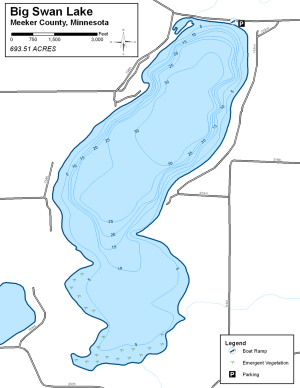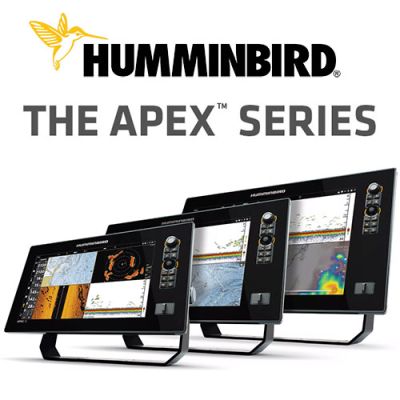Today's Best Fishing Times
Get the best fishing times for Big Swan Lake with Lake-Link's Fishing Forecast. SEE MORE
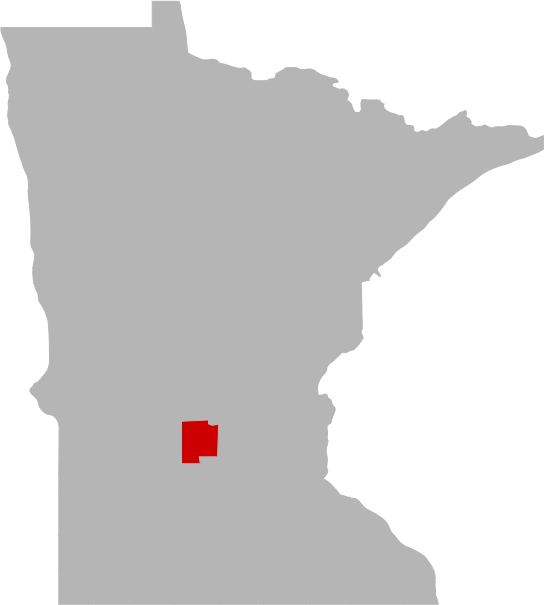

Share Your Catch & Win!
Frequently Asked Questions About Big Swan Lake, MN
- How big is Big Swan Lake?
- How deep is Big Swan Lake?
- What kind of fish can you catch in Big Swan Lake?
- Are there places to stay in the Big Swan Lake area?
- Are there topographical lake maps available Big Swan Lake?
- Are there boat launches on Big Swan Lake?
- Are there places to eat and drink near Big Swan Lake?
- What is the average air temp for Big Swan Lake?
How big is Big Swan Lake?
How deep is Big Swan Lake?
What kind of fish can you catch in Big Swan Lake?
Other fish species in the lake include Bluntnose Minnow, Brook Silverside, Common Shiner, Fathead Minnow, Green Sunfish, Hybrid Sunfish, Johnny Darter, Logperch, Shorthead Redhorse, Silver Redhorse, Smallmouth Buffalo, Spottail Shiner and White Sucker.
Are there places to stay in the Big Swan Lake area?
More Lodging Options
Are there topographical lake maps available Big Swan Lake?
Are there boat launches on Big Swan Lake?
Are there places to eat and drink near Big Swan Lake?
Explore the Big Swan Lake area in a RV
Are you looking for an adventurous vacation option that won't break the bank? Look no further than renting an RV! Contrary to popular belief, the process is much simpler than you might imagine. With just a few easy steps, you'll soon be experiencing the ultimate freedom and convenience of exploring the open road in your very own recreational vehicle. And the best part? RV travel can save you up to 60% compared to other types of vacations! With the money you'll save, you'll be able to travel even more and create unforgettable memories along the way. So why wait? Start planning your next adventure today with an RV rental. Learn more about renting a RV.

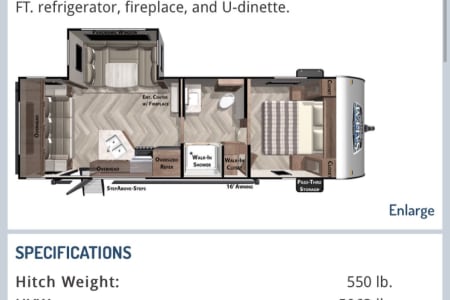

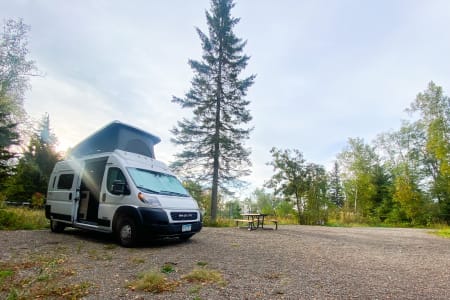
History & Status of the Fishery
A standard survey was conducted at Big Swan in 2016 to monitor the lake's fish population. A total of 18 species, plus Hybrid Sunfish, were sampled in the gill nets, trap nets, and by spring night-time electrofishing. The lake was stratified, on 8/08/16, with the dissolved oxygen concentration falling below 2 mg/l at 18', limiting fish usage of deep water. Water clarity was poor with a secchi disk reading of 2.5 feet, due to an algae bloom. Curlyleaf Pondweed was abundant in the southern basin and the shallows along the west shore during spring night-time electrofishing sampling in May. Anglers may need to adjust their tactics when fishing around this aquatic invasive species, until it dies back in late June.
Gill nets sampled moderate to high numbers of Northern Pike (77) for a catch rate of 8.6/net, which was above the normal range for this type of lake, or what we would expect from lakes similar to Big Swan Lake. The 2013 catch rate was similar at 9.4/net. Net catches in 2013 and 2016 were the two highest ever measured at Big Swan. Historic catch rates from 1971 to 2016 (n=11) were variable, ranging from 0.5 to 9.4/net with an average of 4.6. Historically, recruitment could be classified as low (0-4.9/net) at Big Swan, but recent catch rates indicated that Northern Pike numbers could be on the increase. In 2016, gill netted Northern Pike were 16.9 to 32.6 inches long with an average of 21.6. Approximately 49% of the gill net sample was 21 inches or longer while 11% were 28 inches or longer, indicating a quality size structure. Northern Pike were age-1 to age-6, with five year classes being present. Age-1 and age-2 fish were well represented accounting for 39% and 45% of the gill net aged fish, respectively. Growth would be considered moderate or fast.
Trap nets sampled low numbers (27) of Black Crappie for a catch rate of 2.5/net, which was within the normal range for lakes similar to Big Swan. The 2013 catch rate was also low (3.6/net). Catch rates from 1971 to 2016 (n=12) were highly variable, ranging from 0.0 to 100.2/net with an average of 17.8. Trap netted Black Crappie were 2.4 to 11.0 inches long with an average of 7.2. Approximately 22% of the trap net catch was 9 inches or longer. Gill nets sampled low numbers of Black Crappie (56) for a catch rate of 6.2/net, which was within the normal range for this type of lake. The 2013 gill net catch rate was similar (6.8/net). Catch rates from 1971 to 2016 (n=11) were variable, ranging from 0.0 to 34.0/net with an average of 14.2. Gill netted Black Crappie were 5.6 to 13.6 inches long with an average of 8.1. Approximately 32% of the gill net sample was 9 inches or longer, indicating a quality size structure. Black Crappie (all gears) were Age-0 to age-5, with six year classes present. Age-1 fish were most abundant, accounting for 62% of the gill net sample. This data also indicated inconsistent recruitment in recent years. Growth was fast. Extreme water level fluctuations, could explain the high variability in trap nets catches over the decades, likely indicating that gill nets provide more reliable data on Black Crappie at Big Swan.
Gill nets sampled high numbers of Walleye (79) for a catch rate of 8.8/net, which was above the normal range for lakes similar to Big Swan. Walleye were the most abundant fish sampled by gill nets in 2016. The 2013 catch rate was much lower (3.8/net). Catch rates from 1971 to 2016 (n=11), under various stocking regimes, were variable ranging from 0.0 to 13.7/net with an average of 4.3. In 2016, gill netted Walleye were 12.5 to 25.8 inches long with an average of 16.5. Approximately 70% of the gill net catch was 15 inches or longer, indicating a quality size structure. Walleye were age-2 to age-15 with eight year classes present. The 2014 year class was ranked as strong, accounting for 50% of the gill net catch and may have been the result of the large fall yearlings (1.3/pound) stocked in 2015. The 2013 year class was also strong, making up 37% of the gill net catch and could have resulted from the fingerlings (45/pound) stocked that year. All other year classes were considered to be weak. Growth was fast. The current stocking regime (676 pounds of fingerlings every other year) was initiated in 2009. Additional yearlings were stocked in 2011 and only yearlings were stocked in 2015 due to fingerling shortages. Non-stocked year classes (n=6), age-1 to age-15, in the stocking regimes accounted for 4% of gill net aged walleye. The contribution from natural reproduction during stocked years (fingerling/yearling) was unknown, indicating that natural reproduction or immigration was occurring. Gill net catches during the latest stocking regime (2013 and 2016) ranged from 3.8 to 8.8/net with an average of 6.3. The lake's connection to the North Fork of the Crow River, and possible immigration of river Walleye, makes it difficult to properly evaluate Walleye stocking and natural reproduction at Big Swan. Higher numbers of Northern Pike, in 2013 and 2016 (average of 9.0/net), may be negatively affecting Walleye recruitment at Big Swan.
Gill nets sampled high numbers of Channel Catfish (70) for a catch rate of 7.8/net. The 2013 catch rate was 12.0/net. Historic catch rates, from 1971 to 2016 (n=11), were variable, ranging from 0.0 to 12.0/net with an average of 3.9. In 2016, Channel Catfish were 13.5 to 27.5 inches long with an average of 19.8. Approximately 93% of the gill net catch was 15 inches or longer, indicating a quality size structure. The gill net size distribution indicated that multiple year classes were present. Channel Catfish were last stocked in 1994, indicating that the population is now 100% sustained by natural reproduction. A connection to the North Fork of the Crow River allows this species to move into and out of Big Swan freely. Channel Catfish are easy to catch and their white flesh is tender and juicy. They can also be filleted, just like a Walleye.
Trap nets sampled low numbers of Bluegill (62) for a catch rate of 5.6/net which was below the normal range for lakes similar to Big Swan. The 2013 catch rate was also low (1.5/net). Catch rates from 1971 to 2016 (n=12) were mostly low, ranging from 0.2 to 19.3/net, with an average of 4.0. Eleven out of twelve of the historic trap net catch rates were below the normal range for this classification of lake. In 2016, trap netted Bluegill were 1.5 to 8.3 inches long with an average of 4.3. Approximately 3% of the catch was 7 inches or longer, indicating a poor size structure. Gill nets sampled fish up to 8.4 inches in length. Bluegill were not aged, but size distribution data indicated that multiple year classes were present. Recruitment was inconsistent. Widely varying water levels may limit trap netting efficiency (especially low water years), at Big Swan. As in past years, marginal submergent vegetation habitat was likely limiting Bluegill at Big Swan.
Spring night-time electrofishing sampled low numbers (8) Largemouth Bass for a catch rate of 6.4/hr. The 2007 catch rate was similar (7.2/hr.). Catch rates (n=4) from 1994 to 2016 were all low, ranging from 0.0 to 7.2/hr. with an average 4.6. Largemouth Bass were 10.1 to 17.4 inches long with an average of 11.8. Largemouth Bass (electrofished and trap netted) were age-1 to age-6 with four year classes present. Growth was fast. Data indicated inconsistent recruitment for this species. Largemouth Bass were likely not doing well for the same reasons that the Bluegill were not flourishing (marginal submergent vegetation habitat).
Gill nets sampled low numbers (6) of Smallmouth Bass for a catch rate of 0.7/net, which was within the normal range for this type of lake. The catch rate in 2013 was similar (0.8/net). Catch rates from 1971 to 1994 (n=6) were all 0 and catch rates from 1997 to 2016 (n=5) ranged from 0.1 to 0.8/net with an average of 0.4. That data also indicated an upward trend in abundance over the last 20 years at Big Swan, although numbers were still considered to be low. Gill netted fish were 9.6 to 19.4 inches long with an average of 13.5. Smallmouth Bass (all gears) were age-1 to age-7 with three year classes present. Smallmouth Bass were not sampled during spring night-time electrofishing.
Gill nets sampled low numbers of Yellow Perch (25) for a catch rate of 2.8/net, which was within the normal range for this type of lake. The 2013 catch rate was also low (0.3/net). Catch rates from 1971 to 2016 (n=11) were highly variable ranging from 0.0 to 37.5/net with an average of 7.6. Yellow Perch were 5.5 to 8.5 inches long with an average of 6.7. Approximately 23% of the catch was 8 inches or longer. Yellow Perch scales were not aged.
Trap nets sampled high numbers of Common Carp (60) for a catch rate of 5.5/net, which was well above the normal range for this type of lake. Historic catch rates (n=12) from 1971 to 2016 were highly variable, ranging from 0.1 to 37.0/net with an average of 6.3. Trap netted Common Carp were 11.5 to 29.9 inches long with an average of 19.8. Gill nets sampled high numbers of Common Carp (40) for a catch rate of 4.4/net, which was also above the lake's normal range. Historic gill net catch rates were mostly high, ranging from 0.3 to 57.0/net with an average of 12.2. Gill netted Common Carp were 11.6 to 26.1 with an average of 19.3. Size distribution data indicated that multiple year classes were present. High numbers of Common Carp, over the last 45 years, have likely had significant negative impacts on submergent plant abundance and water quality in Big Swan Lake. Common Carp would likely be difficult to control due to the highly connected watershed that Big Swan was part of.
Gill nets sampled low numbers (11) of Black Bullhead for a catch rate of 1.2/net, which was below the normal range for lakes similar to Big Swan. The 2013 catch rate was 0.8/net. Historic catch rates from 1971 to 2016 (n=11) were highly variable, ranging from 0.8 to 109.5/net with an average of 42.8. Gill netted Black Bullhead were 5.6 to 14.5 inches long with an average of 8.4. Trap nets sampled low numbers (2) of Black Bullhead for a catch rate of 0.2/net which was below the lake's normal range. Trap netted Black Bullhead had an average length of 6.2 inches. In recent years, some area lakes have experienced declines in Black Bullhead abundance and a similar shift seems to have occurred at Big Swan (2007 to 2016 time period). Since 2007, the average gill net catch rate (1.3/net) was much lower than the average from the 1971 to 2002 time period (58.4/net). The exact cause of this shift was unknown, but could be related to increasing numbers of predatory Channel Catfish.
Additional species sampled in the standard gear included; Bigmouth Buffalo, Bowfin, Green Sunfish, Hybrid Sunfish, Pumpkinseed Sunfish, Shorthead Redhorse, Silver Redhorse, White Sucker, and Yellow Bullhead.
What is the average air temp for Big Swan Lake?
Big Swan Lake Reviews
Below is the word on street about Big Swan Lake.Have you been to Big Swan Lake? Why not share your personal reveiw with others?
Submit Review
matt k.

More Nearby Lakes To Explore
There's more lake's to explore around Big Swan Lake...| DISTANCE | ACRES | MAX DEPTH | |
| Little Swan Lake | 1.1 mi | 51 | 31 ft |
| Lake Arvilla | 1.5 mi | 138 | 9 ft |
| Long Lake | 2.8 mi | 168 | 28 ft |
| Spring Lake | 3.9 mi | 203 | 30 ft |
| Brooks Lake | 5.3 mi | 100 | 21 ft |
| Lake Francis | 5.5 mi | 1,053 | 17 ft |
| Cokato Lake | 5.9 mi | 553 | 52 ft |
| Moose Lake | 6.1 mi | 87 | 43 ft |
| Mud Lake | 6.3 mi | 57 | 65 ft |
| Collinwood Lake | 6.5 mi | 636 | 28 ft |


 (1)
(1)

